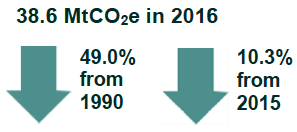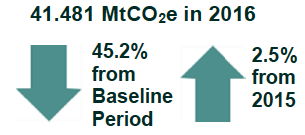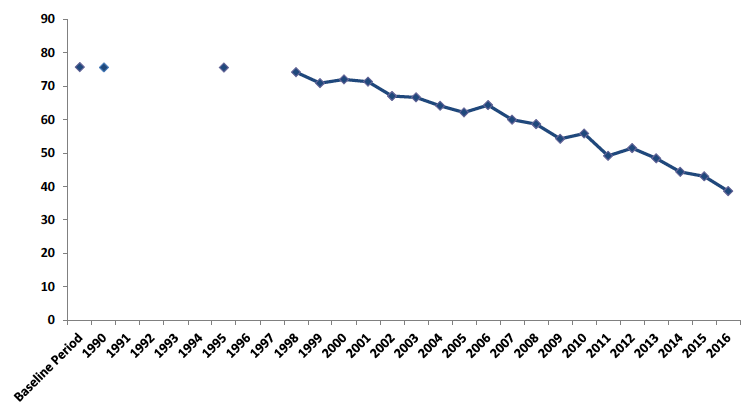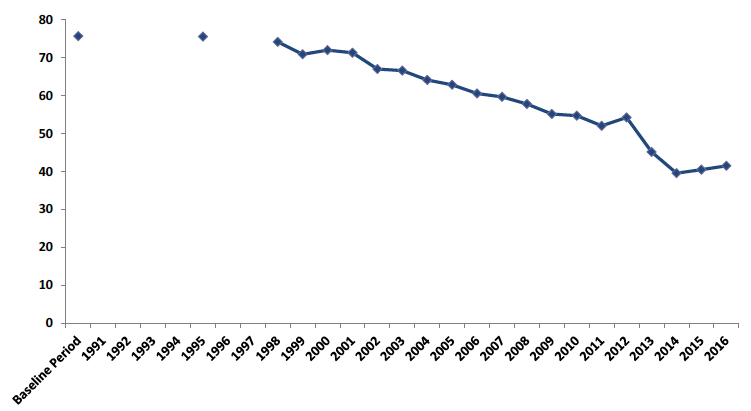Scottish greenhouse gas emissions 2016
This publication provides estimates of greenhouse gas emissions in Scotland for the years 1990 to 2016.
Introduction
There are two measures of greenhouse gases presented in this release:
Source Emissions
A measure of the actual emissions or removals in Scotland. Includes international aviation and shipping. Used for UK and international comparisons.

Adjusted Emissions: For reporting against targets
Emissions adjusted to account for Scotland’s participation in EU-wide emissions trading and are used to measure progress against targets.

The Climate Change (Scotland) Act 2009 provides for a fixed annual target for 2016 of 44.933 MtCO2e, which has been met. The Act also contains a 2050 target for at least an 80 per cent reduction from baseline levels and an interim 2020 target for at least a 42 per cent reduction. By 2016 a reduction of 45.2 per cent had been achieved.
MtCO2e refers to million tonnes of carbon dioxide equivalent. This is a consistent measure of assessing the contribution of greenhouse gases to global warming.
The Baseline Period uses 1990 for carbon dioxide, methane and nitrous oxide and 1995 for hydrofluorocarbons, perfluorocarbons, sulphur hexafluoride and nitrogen trifluoride
Key Trend – Source Emissions
Scottish Greenhouse Gas Emissions, 1990 to 2016. Values in MtCO2e

In 2016, Scottish emissions of the basket of seven greenhouse gases are estimated to be 38.6 million tonnes carbon dioxide equivalent (MtCO2e). This is 10.3 per cent lower than the 2015 figure of 43.0 MtCO2e, a 4.4 MtCO2e decrease.
The main contributors to this reduction between 2015 and 2016 are:
- A fall in Energy Supply emissions driven almost entirely by a decrease of the use of coal in the power generation sector (5.1 MtCO2e; 41.4 per cent reduction). Additionally this reduction in emissions can be attributed to a reduction in emissions from the combustion of fossil fuels in the chemical industry between 2015 and 2016.
Between 1990 and 2016, there was a 49.0 per cent reduction in estimated emissions, a 37.0 MtCO2e decrease.
The 3 main contributors to this reduction are:
- Fall in Energy Supply emissions (such as power stations) (15.6 MtCO2e; 68.5 per cent reduction)
- Fall in Waste Management Emissions (such as Landfill) (4.4 MtCO2e; 72.8 per cent reduction)
- Fall in Business and Industrial Process(such as manufacturing) (5.8 MtCO2e; 40.5 per cent reduction)
More details can be found in Section B.
Key Trend – EU ETS Adjusted Emissions
Scottish Greenhouse Gas Emissions, Adjusted for the EU Emissions Trading System, (EU ETS). 1990 to 2016. Values in MtCO2e

- When emissions are adjusted to take account of trading in the EU Emissions Trading System (EU ETS), emissions increased by 2.5 per cent between 2015 and 2016 (from 40.5 MtCO2e to 41.5 MtCO2e). This is the basis against which progress towards the targets outlined within the Climate Change (Scotland) Act 2009 are measured.
- The EU ETS is an EU policy aimed at mitigating climate change by limiting greenhouse gas emissions from large point source emitters (primarily electricity generation and energy-intensive industries) and in aviation. Under accounting rules of the Climate Change (Scotland) 2009 Act, the contribution of those sectors to the annual targets is determined by the Scottish share of emissions allowances in the EU ETS, rather than the actual level of emissions. Section C provides information on what the EU ETS is and what it means for Scotland’s Greenhouse Gas Emissions statistics.
- Compared with the Baseline Period [1], emissions in 2016 (after taking account of trading in the EU ETS) were 45.2 per cent lower. Section A contains more information on how the Baseline Period is defined and Section C contains results in more detail.
Revisions to greenhouse gas emissions statistics
Note that as part of this release all of the figures have been revised since the previous publication in June 2017, to incorporate methodological improvements and new data. Comparing the 2016 figures with the 2015 figures published a year ago will therefore give a different year-on-year percentage change; one which is incorrect and should not be used. Details of these revisions can be found later in this statistical release in Section D.
Contact
Email: ccstatsmodelling@gov.scot
There is a problem
Thanks for your feedback